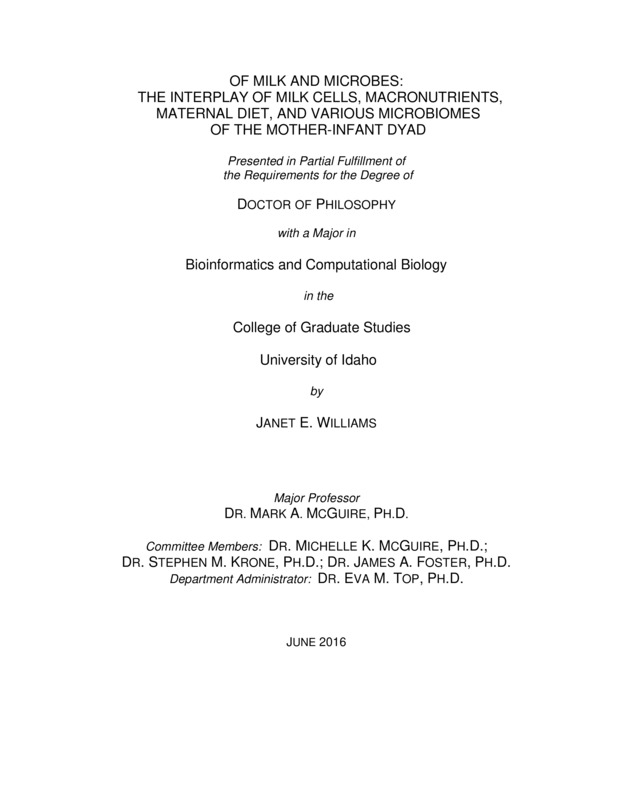Of Milk and Microbes: The Interplay of Milk Cells, Macronutrients, Maternal Diet, and Various Microbiomes of the Mother-Infant Dyad
Williams, Janet. (2016). Of Milk and Microbes: The Interplay of Milk Cells, Macronutrients, Maternal Diet, and Various Microbiomes of the Mother-Infant Dyad. Theses and Dissertations Collection, University of Idaho Library Digital Collections. https://www.lib.uidaho.edu/digital/etd/items/williams_idaho_0089e_10982.html
- Title:
- Of Milk and Microbes: The Interplay of Milk Cells, Macronutrients, Maternal Diet, and Various Microbiomes of the Mother-Infant Dyad
- Author:
- Williams, Janet
- Date:
- 2016
- Embargo Remove Date:
- 2017-07-29
- Keywords:
- human immune cells lactation microbiome microbiota milk
- Program:
- Bioinformatics & Computational Biology
- Subject Category:
- Bioinformatics; Microbiology; Ecology
- Abstract:
-
Human milk is generally considered to be the gold standard of nutrition for healthy human infants. It provides all of the essential nutrients and is rich in non-nutrients (e.g. indigestible carbohydrates), immune cells, and bacteria. To better understand these milk components, we conducted experiments examining the relationships and dynamics of milk-borne host cells, milk macronutrients, maternal diet, and the various microbiomes of the mother-infant dyad.
In Chapter 1, relationships among macronutrients, host cells, and bacterial communities in milk produced by 16 women over a 5-wk period are characterized. A wide variation of host cell types such as neutrophils, macrophages/secretory mammary epithelial cells, eosinophils, and lymphocytes was found. Distribution of these cell types varied greatly among women, but was relatively consistent over the sampling period within individual women. Myriad relationships existed between host cell profiles and the microbial community structure as well as relationships among several human milk oligosaccharides and the host cellular content.
In Chapter 2, the microbiome of milk produced by 21 healthy lactating women during the first 6 months postpartum is described, as well as associations between milk bacteria and other mediating factors such as maternal nutrient intake, delivery mode, and adiposity. Similar to the host cellular content, the microbial community structure of milk was variable among women but relatively constant over time within individual women. Relative abundances of several bacteria were associated with maternal adiposity, delivery mode, infant sex, and maternal diet.
In Chapter 3, relationships among microbial communities of milk, oral, and fecal samples from healthy lactating women, and oral and fecal samples from their infants over the first 6 months postpartum were explored. Microbial communities from each sample type were relatively unique. However, some similarities existed. For example, milk bacterial communities appeared to bridge the infant fecal and infant oral bacterial communities. Over time, however, milk bacterial communities became more similar to the infant and maternal oral bacterial communities than that in infant feces.
In conclusion, these studies demonstrate that regulation of the components of human milk is likely a highly complex process, being individualized to a particular woman.
- Description:
- doctoral, Ph.D., Bioinformatics & Computational Biology -- University of Idaho - College of Graduate Studies, 2016
- Major Professor:
- McGuire, Mark A
- Committee:
- McGuire, Michelle K; Krone, Stephen M; Foster, James A
- Defense Date:
- 2016
- Identifier:
- Williams_idaho_0089E_10982
- Type:
- Text
- Format Original:
- Format:
- application/pdf
- Rights:
- In Copyright - Educational Use Permitted. For more information, please contact University of Idaho Library Special Collections and Archives Department at libspec@uidaho.edu.
- Standardized Rights:
- http://rightsstatements.org/vocab/InC-EDU/1.0/

